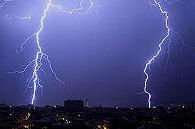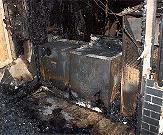This technical article relates to the increasingly important topic of electrical surges, which can damage sensitive electrical and electronic equipment. Surge protection devices (SPDs) play a vital role in protecting sensitive electrical and electronic equipment from damage caused by overvoltages or other electrical power surges or spikes. But what are the issues, and how do surge arrestors work? Voltimum managing editor James Hunt reports:

Overvoltages, electrical power surges or spikes are fast, short duration electrical transients in an electrical circuit. An overvoltage is a voltage pulse (or wave) that is superimposed on the rated voltage of the network, and it can disturb equipment and produce electromagnetic radiation. Moreover, the duration of the overvoltage causes an energy peak in the electric circuits which could damage or even destroy equipment.
Voltage spikes or surges are fast, short duration electrical transients in an electrical circuit. Fast, short duration electrical transients in the electrical potential of a circuit are typically caused by lightning strikes, tripped circuit breakers, short circuits, power outages, power transitions in other equipment on the same power line, malfunctions caused by the power utility, storm-damaged powerlines, and electromagnetic pulses in the 100kHz - 1MHz frequency range.
Up to 80% of such transients are generated from internal sources such as inductive load switching and normal equipment operations, while at least 20% of transients are generated from external sources such as lightning and power utility switching.
Overvoltage types:
Various types of overvoltage can disturb electrical installations. These include the following:
Power-frequency overvoltages –These are of the same frequency as the network caused by a permanent change of state in that network – for example, after an insulation fault occurs, or the breakdown of the neutral conductor.
Switching surges – These are high-frequency overvoltages or burst disturbances caused by a change in an electrical network steady state – typically because of switchgear operation. The switching off of lighting and the starting and stopping of AC motors can be the cause of this type of surge.
Electrostatic discharge – This causes very short overvoltages (a few nanoseconds) of very high frequency caused by the discharge of accumulated electric charges. An example of this can be a person walking on a carpet with insulated soles, who can become electrically charged to several kV.
Lightning strike – This can produce extremely large pulsed electrical energies of several thousand amperes (typically 2000 - 400,000A) and many tens or hundreds of thousands of volts at high frequency (typically around 1 mHz) over micro- to millisecond short duration. Lightning damages electrical and electronic systems such as transformers, electricity meters and electrical appliances. It can also cause damage or disturbances to computers, telecommunications networks, and cause faults in programmable logic controller (PLC) programs and other control systems.
Some surge arrestors designed to protect three-phase systems against lightning strike are said to be able to pass currents of 320,000A/phase (equivalent to 1,200,000A total).
The overall result of various overvoltages can be cumulative equipment damage and possible premature failure, expensive system resets and down time and data losses. It can even result, especially from lightning strike, in catastrophic equipment failure resulting in immediate shutdown, as well as longer term disruption of businesses, plus expensive equipment repair and replacement costs. Lightning also causes a large number of fires, mostly in agricultural areas, but high-rise buildings are especially at risk.
Surge prevention:
The prevention of such potential damage is through use of surge arrestors (or 'surge suppressors'), generically known as Surge Protection Devices (SPDs). These protect electric power supply networks and other equipment, telephone networks and communication and automatic control buses. The devices regulate the voltage supplied to electric device and/or systems by shorting to earth voltages above a safe threshold, or by blocking. This limits overvoltage amplitude to a value that is not hazardous for the electrical installation. For example, a transient voltage surge suppressor protects against transient voltage spikes that occur in less than 0.000000001s. SPDs today cover IEC, UL, telecommunications installations and many more.
The rapid and continuing growth of solar photovoltaics (solar PV) and wind turbines means further applications for SPDs, especially as solar PV arrays, with their metal roof-mounted frames, are excellent lightning conductors, as are wind turbines. Both are easily damaged by lightning strike, so surge protection should be high on the agenda. The loss of a single day through downtime for a 1.5MW machine is estimated to cost around $85,000 (source: NREL), so lighting strike protection is essential.
Surge arrestor types:
Metal oxide varistor (MOV) - This, the most common protector component in AC power arrestors, contains a current-conducting material (typically granular zinc oxide) that conducts current when a voltage above rated voltage occurs - such as a spike. MOVs typically limit voltages to about three to four times the normal circuit voltage by diverting the surge current elsewhere. MOVs have the disadvantage of being degraded when subjected to several large transients - or a greater number of smaller transients. To overcome this problem, MOVs can be connected in parallel to increase current capability and life expectancy; however, they must be arranged in matched sets.
Transient suppression diode - This is a type of zener diode that limits voltage spikes - usually to less than twice the normal operational voltage. It is also sometimes termed an avalanche diode or suppression diode. Transient suppression diodes are claimed to provide the most suitable limiting action of protective components for many applications, but have a lower current capability.
Note that as long as current variations stay within device ratings, transient suppression diode life expectancy is very long, but if ratings are exceeded, the diode may fail as a short circuit. Because of their relatively limited current capacity, transient suppression diodes are usually used with circuits likely to be exposed to smaller current spikes, and where such spikes are likely to occur more often. Note that bi-polar operation is possible using a transient diode containing reversed paired avalanche diodes.
Selenium voltage suppressor - This type is, in some ways, similar to a MOV but is less effective in terms of let-through voltage, yet has a longer life. The type can dissipate power continuously and retains its voltage let-through characteristics throughout the surge event. Selenium voltage suppressors are mainly used in high-energy DC circuits, such as an alternator exciter field.
Quarter-wave coaxial surge arrestor - This type features a tuned quarter-wavelength short-circuit stub that allows the arrestor pass a bandwidth of frequencies - while presenting a short to any other signals, especially down towards DC. The bandwidths can be narrow or wideband. This type of surge arrestor provide, it is said, the best and most reliable protection for RF signals above 400MHz, so it tends to be used in RF signal transmission routes.
Gas discharge tube (GDT) - This type relies on a gas trapped between two electrodes that is ionised by the high voltage to conduct electrical current. GDTs can conduct more current for their size than other components. Like MOVs, they have a finite life expectancy, and can accept a few very large transients or a greater number of smaller transients.
The type also takes time to trigger, so that a higher voltage spike can exist before the arrestor conducts significant current. Therefore, it is sometimes necessary for extra protection to be provided to prevent damage because of the longer trigger time. GDTs find most applications in telecommunications equipment and in HF lines.
Combined lightning current / surge arrestor - This is necessary in terms of the energy co-ordination requirement between the various surge arrestor devices and the devices to be protected. The combined lightning current / surge arrestor is the result, and it features a high discharge capacity for lightning currents (accommodating the waveform necessary for lightning equipotential bonding), and a voltage protection level of below 1.5kV for safe insulation co-ordination with terminal devices and the electrical installation operating equipment.
A combined arrestor also provides energy co-ordination with downstream surge protection devices in the installation and with the consumers to be protected.
Coordinating SPDs:
Suitable surge arrestors must be energy co-ordinated so that the total loading of the protective devices is subdivided according to their power carrying capability. This is to ensure that the lightning voltages etc will be reduced to levels below the immunity of devices to be protected. Typically, coordination involves the following device classifications:
Type 1 SPD (10/350µs current wave) - Installed in the main electrical switchboard when the building is equipped with a lightning protection system, this type can discharge a very high lightning current that might be fed into the power distribution system. This is recommended for service-sector and industrial buildings that are protected by a lightning protection system or a meshed cage. This type can discharge the back-current from lightning spreading from the earth conductor to the network conductors.
Type 2 SPD (8/20µs current wave) - This type is the main protection system for LV electrical installations. Typically installed in main distribution switchboards, it prevents the spread of overvoltages in the electrical installations and protects the loads in power distribution networks.
Type 3 SPD (voltage waves of 1.2/50µs / current waves of 8/20µs) - This type has a low discharge capacity, so should not be used alone and must be installed as a supplement to Type 2 SPD near sensitive loads.
Choice of SPD:
When designing a system or selecting an SPD for a specific application, the main parameters to be considered are typically, the maximum discharge current for lightning, the short-circuit current at the point of installation, the short circuit protection device used, the SPD itself and the numbers to be used, plus their likely level of exposure. An SPD should always be installed at the electrical installation's origin.
Important parameters that affect the design - and also the choice - of SPD, include the let-through voltage. This specifies the voltage that will cause an arrestor to conduct electricity to the earth line. A lower let-through voltage should provide greater protection, but with a shorter surge arrestor life.
Another important parameter is the energy that it can absorb without failure. The greater the energy, the greater the protection, and also the longer the life expectancy. This is because the device will divert more energy elsewhere and will absorb less of it. The greater the energy conducting the same surge current, the lower the let-through voltage.
The response time is another important aspect, because surge arrestors don't work immediately - there is always a very slight delay. This is an important factor because the longer the response time, the longer the connected equipment will be exposed to the surge. Luckily, since voltage spikes and surges also take time to evolve, surge arrestors usually have enough time to suppress the most damaging part of the spike/surge concerned.
